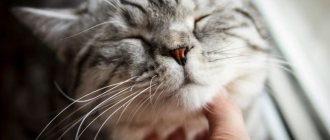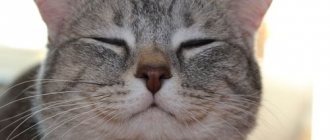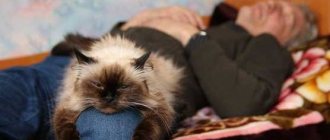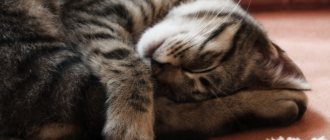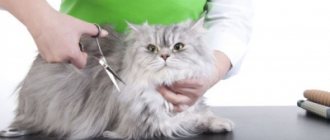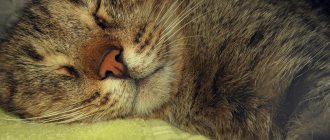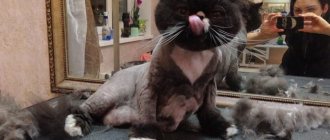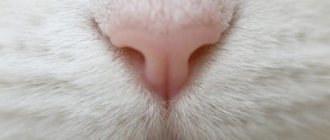In what situations do cats purr?
What does the purring of felines mean?
There are many reasons. Most often, pets express their satisfaction and love for their owner in this way. At the same time, cats purr in stressful situations, when they are sick, afraid or dissatisfied. The owner can recognize the emotional state of his pet by the timbre of the rumbling and the level of muscle tension in the animal’s body.
Pleasure, joy, gratitude
Cats begin to purr from childhood, when they communicate with their mother. Vibrating sounds serve as a signal to kittens that they are okay, fed and feeling well. During feeding, the mother cat also purrs, thereby letting the kittens know that they are safe. In the wild, purring is necessary for protection from predators. During a hunt, a cat hears the purring of kittens even at a long distance, but these sounds pass by the ears of predators. Cats also purr for the following reasons:
- Gratitude.
After receiving a favorite treat or affection from the owner, the cat begins to purr as a sign of gratitude. - Greetings.
Cats often greet their owners with joyful meows and purrs. In this way they demonstrate their positive emotional state and benevolent attitude. - Request.
Seeing that the owner is heading to the kitchen, the cat often begins to purr in the hope of getting something tasty. - Preparation for sleep.
Rumbling helps pets relax and “disconnect” from irritating signals (lights, sounds, smells). The animal's emotional state improves and it sleeps better. - Flirting with a member of the opposite sex.
During love games, cats communicate with cats by purring - this is part of the animals' foreplay.
There is a version that purring is the prevention of muscle diseases in cats. These animals spend most of their lives sleeping, and rumbling helps to some extent replace the load on the musculoskeletal system. The vibration spreads throughout the pet’s body, which has a beneficial effect on the bones, ligaments, and muscles of the whole body.
Cat purring has a positive effect on the human body. It not only relaxes, but also normalizes blood pressure and improves the functioning of the cardiovascular system. A pet is able to alleviate the condition of its owner with pain in muscles and joints, and diseases of the gastrointestinal tract. Cats feel the warmth emanating from the inflamed organ and lie down in a certain place. In addition, vibration has a positive effect on bone tissue and strengthens the immune system. This is a great reason to pet your pets more often and enjoy their purring.
Illness, fear, discontent
Purring can serve as a way for a cat to calm itself in stressful situations. Rumbling stabilizes blood pressure, evens out the pulse, which brings the nervous system back to normal.
Sick animals also purr often. This is due to the fact that the vibration frequency acts on their body as a pain reliever.
Rumbling speeds up metabolism and promotes faster healing of wounds, which is important for operated pets. At the same time, the cat purrs at a lower frequency, the sounds are slightly different from a peaceful purr
There is something called “purring disease,” or feline infectious peritonitis (FIP). This is a viral disease manifested by inflammation of the gastric mucosa.
The disease usually occurs as a result of a complication of coronavirus. With the “wet” form of ICP, blood vessels are damaged and fluid enters the abdominal cavity and lungs. With this type of peritonitis, the cat's abdomen swells and rumbling is often heard. The “dry” form of the disease is manifested by loss of appetite, dulling of the coat, yellowing of the eyelids and constant purring.
Why else do animals purr? Pets may purr with displeasure when meeting an unpleasant person or relative. If you carelessly pet a cat, it will express its dissatisfaction by purring, while its body will be tense. You can tell that a cat is uncomfortable by looking at her and the expression on her face. When a cat meets a stronger relative, he begins to purr as a sign of defenselessness. Thus, he tells the other animal that there will be no attack from him, he is not inclined to aggression.
Why do cats purr and what does it mean?
Cats have conquered the whole world. And the gentle purring definitely helped them with this! Did you know that purring is not only pleasant music for our ears, but also has health benefits?
Numerous studies by American scientists (*researchers Robert Eklund, Gustav Peters, Elizabeth Duthie from the University of London, animal communication specialist Elizabeth von Muggenthaler from North Carolina and others) have shown that the purring sounds and vibrations of a cat’s body have a positive effect on human health. They calm you down, even out your breathing and heart rate, eliminate stress and insomnia, and even strengthen your bones! It's no surprise that cats are the stars of pet therapy.
How do cats purr?
Have you ever wondered where the organ responsible for purring is located in a cat? What processes take place in the body for us to hear the cherished “purrr”? How do cats do it anyway?
The purring process originates in the brain: electrical impulses arise in the cerebral cortex. They are then “thrown” onto the vocal cords and cause them to contract. The vocal cords move, alternately narrowing and widening the glottis. And then the fun part. The cat has a special purring organ - the hyoid bones. When the vocal cords contract, these bones begin to vibrate - and that’s when you and I hear the treasured “urrrrr”. Usually the “purr” occurs when the cat exhales, and its body pleasantly vibrates to the beat.
Do all cats purr?
Do you think only domestic cats can purr? In fact, this is the talent of many representatives of the cat family, and with them some viverrids.
Yes, yes, wild cats purr in their natural habitat, just like your Scottish Fold. But the frequency, duration and amplitude of their purring are noticeably different. Thus, the frequency of a cheetah's purr is approximately 20-140 Hz, and a domestic cat falls within the range from 25 to 50 (*according to Elisabeth von Muggenthaler, a specialist in the field of bioacoustics from the Institute for Fauna Communication in North Carolina.).
Talented “purrs” in the wild are, for example, lynxes and forest cats, and among civets, common and tiger genets (civets). They would definitely give your purr a run for their money!
What does it mean when a cat purrs?
It is generally accepted that a cat purrs when she feels good. So she feasted on her favorite sausage with tuna and settled down on the warm lap of the hostess - how can she stay here?
Indeed, a pet purrs when it is fed, warm and calm. He may reward you with a gentle purr when you talk to him affectionately. When you scratch his ear. When you go to the refrigerator to get canned goods. When giving a super soft fleecy bed. In a word, when you create comfortable, safe conditions and show your love. But these are not all the reasons.
It turns out that a cat can purr not only when she feels good, but also when she feels very bad.
Many cats begin to purr during childbirth or when they are sick. Others purr when they are stressed, afraid or angry. For example, a cat may suddenly purr while sitting in a carrier on a rumbling bus. She probably doesn't like this journey. Most likely she is afraid.
There is a theory that purring promotes the production of a hormone that reduces pain and calms the cat. That is, if a cat feels bad, it begins to purr to heal or calm itself. Researchers at the University of California believe that purring (or rather, body vibration) also tones the musculoskeletal system. After all, cats are avid sleepers; they spend a lot of time without moving. It turns out that purring is also a kind of passive fitness.
Purring is also a way of communication. By purring, cats communicate with humans and with each other. The nursing mother begins to purr so that the kittens will react and crawl up to drink milk. During feeding, she continues to purr to calm her babies. Kittens purr to tell their mother: “We’re full.” Adult cats purr to invite their fellow cats to play. But the most amazing thing is that a healthy cat can start purring when it sees another cat that is in pain. Empathy is not alien to them.
Researchers have not yet established all the reasons why cats purr. However, it is known that each pet has several variants of purring, and each of these variants has its own purpose. The cat knows exactly how to purr so that you give her a treat. And she purrs completely differently when she’s just bored or when she’s interacting with another cat. These are such charming animals with their own “superpowers”.
Why does a cat purr and stomp its paws?
Cat owners often ask why a cat purrs and tramples something with its paws at the same time. For example, a pillow, a blanket or the owner’s lap? The answer is pleasant: at these moments your cat feels very good.
For cats, this behavior is a throwback to deep childhood. When kittens drink mom's milk, they purr and massage mom's belly with their paws ("milk step") to increase milk flow. For many, this scenario is not forgotten even in adulthood. Of course, the cat no longer asks for milk. But when she feels good, nourished, warm and safe, the child’s pattern of behavior makes itself felt.
If your cat often purrs and paws at you, congratulations: you are a great owner!
What to do if your cat stops purring?
And this also happens. The owners say that their cat does not know how to purr at all, or that at first she purred and then stopped.
The first one is simple. Do you remember that each cat has its own purr? Some pets rumble like tractors throughout the house, while others do it silently. Sometimes you can understand that a cat is purring only by a slight vibration of the chest or abdomen - you can feel it by placing your palm on the cat. It turns out that you don’t hear “purr”, but the cat actually purrs.
Each cat has its own purr, it is an individual innate feature. Some purr loudly, others almost inaudibly. This is fine.
It’s another matter if at first the cat purred, and then suddenly stopped and hasn’t purred at all for a long time. Most likely it's stress. Perhaps the cat no longer feels safe. She may have lost trust in you or is jealous of your other pet or child. Sometimes this behavior can become a symptom of illness.
Your correct action in this case is to contact a veterinarian to rule out health problems, and consult with a zoopsychologist. An animal psychologist can point out points of content that you had not thought about before, but which turned out to be important, and will help you establish an “owner-pet” connection.
How to help a cat purr?
If your cat is healthy and feeling well, you can “help” her purr by introducing new toys and treats into your interaction. These are reliable tools both in establishing contact and relieving stress, and in education. Play with your cat more often in a calm atmosphere, demonstrate your involvement, your attention, and for success (or just because) treat him with healthy treats from the palm of your hand.
Don't expect a quick response. Your task is not to achieve purring immediately after you have played teasing with your cat and treated it to sausage. No. You must show her that you are a team. That you can be trusted. That you love her and care about her. That she's safe at home.
And then, one fine day (most likely suddenly and unexpectedly) your cat will jump onto your lap, curl up in a ball and rain down on you the most melodic and velvety “purr” that she is only capable of. Enjoy, you deserve it!
Reasons why it tramples
A cat is a unique animal that, having accepted a person’s offer to live in his home, has retained its wild roots. Because of this, the instinct, due to which a cat stomps on the bedding with its front paws or moves them while sitting in the arms of the owner, appears from time to time in many domestic pets, even the most decorative ones. It turns on in an animal for several reasons.
- Memories of wild life. The ancestors of domestic cats were forest dwellers, who over time agreed not just to be neighbors with humans, but also to form close friendships. The cat has retained some of the habits of its former life to this day. There are enough poisonous insects and snakes in nature that are not averse to resting in the cozy bedding of a cat’s den, so when a cat returns from a hunt, it is sure to trample on it with its front paws, driving out uninvited guests. This also helped to check the litter for the presence of sharp branches that could injure the animal. Domestic cats play at preparing a den, remembering their wild past, and begin to rhythmically stomp their paws on the place where they are going to lie down.
- Childish instinct. Some cats have a childish instinct that they retain from birth until their last days. While still blind, kittens, starting to suck their mother's milk, actively knead the cat's belly with their paws, stimulating her lactation. At this moment, babies do not yet have contact with the outside world and therefore do not experience such an unpleasant feeling as fear. They are confident that they are completely safe next to their mother. Domestic cats trample their owners with their paws and begin to purr with pleasure, returning to childhood because of complete security.
- Hunting period. This behavior is typical for both male and female cats. When a pet has a desire (a cat is in heat, and a cat is chaotic), he begins to behave more playfully, and also meows often and loudly, calling his partner. Trampling cats with their paws is typical for them during this period, even when the animals are kept alone, since their behavior is dictated by the cat's instinct. The cat tramples with its front paws on the bedding or owner, since at such a moment it is natural for the animal. Most often, when working with their paws, cats strongly arch their backs, and cats can imitate mating.
- Manifestation of full recognition of a person as his property. Cats, living next to a person, can still remain independent and accept him only as a source of food. However, if a close connection is established between the owner and his pet, then the cat accepts the person as its property. In the human understanding, he will never be an owner for an animal. The cat, while caressing, begins to actively mark its owner and, to do this, tramples with its front paws, on the pads of which there are a large number of special glands. Also, at the same time, the pet often leaves marks with saliva.
shutterstock
Whatever the reason for a special cat massage, the owner must know how to stop this phenomenon if it causes discomfort.
Other situations when cats purr
Among other things, the cat also begins to make similar sounds when she feels bad, so she tries to calm and relax herself on her own. This happens extremely rarely.
Why do cats purr differently when they're angry? If someone else is standing near the bowl, the animal may start turning on the engine, but more aggressively, making it clear that any threat to its food is extremely outrageous.
When a kitten is hunting, he is in a state of excitement and begins to make the most funny and amazing sounds.
Why do cats purr when they fall asleep? Everything here is extremely simple: for pets this is one of the methods of combating insomnia, as for humans, for example, counting sheep or listening to the sounds of rain.
Anatomy of a purr
There is an opinion that purring is born deep inside the cat. In fact, the urcal is located much higher, in the area of the vocal cords. It is not known for certain whether the process of purring occurs consciously. Experts say that vibration originates from the central nervous system of the mouse.
What is the cat purring about?
It is there that a nerve impulse arises, causing vibration of the vocal cords. The air pushed out by the diaphragm affects the vibrating ligaments, and the output is everyone's favorite purr.
Experts have long been looking for an explanation for this mechanism. Research in the United States has shown that air passing through a cat's larynx affects two folds called false vocal cords. Moreover, this happens both during inhalation and exhalation. This fact proves the uniqueness of the purring form of communication, since a person, for example, can produce sound only when exhaling.
Do cats purr among themselves?
Cats use purring not only to communicate with humans. In addition to the dialogue between mother and kitten, you can hear two adult cats quietly “talking” about their own, cat-related things.
One of the signs of a good-natured greeting between cats is purring. A high tail, combined with guttural vibrations, is a sure sign of a welcome guest. The cat is happy to see its relative and is ready to make contact with him.
Furry dating
Cats living in the same territory resort to purring when washing themselves. By caring for each other's fur, the cats calm down and also take care of their friend. Another reason for rumbling is the call to play. Wanting to cheer up his neighbor, the cat begins to influence him with his weapon - loud purring.
Purring for a person
It is known that cats learned to meow in order to communicate with humans. Purring is a more universal language. With its help, murkas turn to both people and relatives.
There is no single reason for a cat to purr. Fluffy pets put a huge range of feelings into vibrating sound. It can be joy, fear, or peace.
It has been noticed that some pets use purring to try to cheer up their owner, who is in a sad mood.
The cat persistently seeks the activity of a depressed person, trying in every possible way to attract attention. At the same time, her urinal inevitably works at full capacity
Some Murkies resort to cunning, trying to beg for a treat with the help of the treasured Murrr. Playing on the feelings of a loving owner, the cats purr in the name of cutlets and sweets. A person lulled by cat emotions becomes generous and kind.
Purr in action
Furry therapy, or the benefits of a cat's purring
Scientists say that a cat's purring has healing properties. It's all about the frequency at which the vocal cords vibrate. Sound in the range from 20 to 50 Hz (namely, the frequency of purring) has a beneficial effect on bone growth.
The human body detects vibrations of this frequency using nerve endings on the surface of the skin. The impulses entering the brain calm the nervous system and give peace. Thus, it has been proven that cats can indeed relieve stress.
Moreover, research is currently underway to use cat purring in the fight against osteoporosis. It's all about the negative energy that cats are able to direct towards themselves.
Owners often notice that cats try to lie down on the owner's sore spot. And for good reason. It has been proven that cats accurately determine the area of discomfort. Moreover, females have a greater “healing” effect, not males.
Cat therapy
Interesting facts about cats purring
- The cat's purring is uncontrollable. If a cat decides to lull a person to sleep with sweet vibrations, only one sound can stop it - the sound of running water.
- While the cat is purring, it is impossible to listen to its heartbeat.
- Even kittens, deprived of the ability to hear from birth, are endowed with the talent to purr.
- There is a theory that cats developed the ability to purr specifically for communication with humans.
- A certain cat, Smokey, set a world record for being the loudest purring cat. The frequency of sounds produced by a cat's purr reached 70 decibels. For example, a vacuum cleaner operates at a frequency of 75 decibels. Why the cat purrs so loudly is unknown. The owners claim that this feature of the pet does not bring any particular inconvenience.
Purring is one of the secrets that murki possess, and which are still incomprehensible to humans. It is not yet known for certain how cats manage to purr, but it is known exactly why - to touch and warm a person.
Source of purring
When asked where the urcal is located in cats, many will answer - in the larynx. Her muscles vibrate 25-150 times per second, separating her vocal cords. As a result, a calming sound emanates from the pet’s chest as it inhales. The movement of the larynx is the final answer to the question of how cats torture.
Other theories have also been put forward. So the heart was previously considered the place where cats purr. It was assumed that the characteristic sounds are generated due to the movement of blood with a low level of oxygen through the inferior vena cava to the organ.
In addition to the throat zone, other systems are also involved in the process. So, sound originates in the brain. Signals from the central nervous system are transmitted to the larynx, provoking vibrations with a frequency of 20-150 Hz. The larynx-brain connection will likely be the final explanation for where the larynx is located in cats.
Experts may reveal more details about the process, but vibrations of the throat in response to signals from the central nervous system seem to be the obvious basis.
What to do if the cat no longer purrs
Determine the cause of this phenomenon.
In some cases, by not purring, your pet may simply be showing character. Or show offense. (If your pet has suffered undeservedly, apologize to the cat: take him in your arms, stroke him, treat him with your favorite treat)
If the absence of purring is accompanied by apathy, lack of playfulness, poor appetite and lethargy, you should immediately contact a veterinarian.
What does purring mean?
Kittens use purring as a means of communicating with their mother. Moreover, they can purr already 48 hours after their birth. This can continue until they feed on the milk of their mother cat and reach 5 weeks of age. During this process, the mother of the kittens calms them down with mutual purring.
Purring is also accompanied by the procedure when a mother cat licks her cubs, caring for their fur and washing them. As kittens grow up, they will use similar sounds to communicate with other cats and, of course, with people.
With these mesmerizing sounds, cats express satisfaction. They anticipate the pleasure of the expected food. They rejoice when they meet their owners upon returning home. They experience pleasant sensations from their owner's hands stroking them.
At its core, purring is a way of showing people that you are dependent on them. As once before, they also purred to their mother, completely dependent on her. And of course, as a way to show the importance of the emotion experienced in this case.
By the way, cats that are sick, injured or injured can also purr. By and large, they do this on a subconscious level in order to calm themselves down.
How do cats purr?
Today, the main version is that a certain part of the cat’s brain is responsible for rumbling.
, sending impulses directly to the vocal cords, which begin to vibrate, appearing on the hyoid bones, and spreading vibration throughout the body.
Interesting facts about cat purring
- Cats don’t purr; if there is another cat in the room, they don’t need this type of communication. That is, they purr alone with themselves or with a person.
- Not only animals, but also humans benefit from rumbling, since this sound and vibration of cats when you pet them have a positive effect on the human body. (can relieve fatigue, apathy, headache, in some cases even normalize blood pressure)
- A purring animal's heartbeat cannot be heard, so veterinarians have to wait for the cat to calm down, or turn on the water to distract it.
Don't chase away a purring cat! Better stroke it, relaxing your nervous system, becoming calmer and happier.
The nature of the mysterious cat purring is shrouded in mystery. As soon as you stroke the cat's fur, he immediately purrs. So the man decided that rumbling is a sign of gratitude and satisfaction. But cats purr when they are in danger, during childbirth, when they are in pain. In order to find out the reason for this behavior, let’s find out where the cat’s purr is located and how it works.
Cat design
Main reasons
There are many versions that explain the reason for the rumbling of domestic cats. The following options are recognized as the main ones.
- Gratitude.
Cats purr when they show gratitude to a person for treats, affection, touches and warmth. In this regard, a barely audible purr is a sign of a contented cat. - Relaxed state
. If the pet is in a calm state, then it begins to purr. The same situation can be observed when kittens, sitting in a calm and peaceful state, suck their mother’s milk. Since it is not possible to meow and eat food at the same time, they purr barely audibly. - Showing your emotions.
Most people believe that when a cat purrs, it means the cat is singing its song. With the help of different intonation, pronunciation of sounds and vibrations, pets demonstrate their mood at the current moment. This is comparable to people who, in a relaxed state, begin to hum certain tunes to themselves. - Conversations between kittens and mother cat.
With the help of rumbling, little children tell their mother that everything is fine with them, they are full and satisfied. This indicator is important among wild felines, since parents can often leave their children alone when going hunting. - When self-medicating.
If a cat is sick or stressed, it begins to purr to find peace and restore the state of its body. With the help of vibrations produced by cats, blood circulation processes are improved, which improve metabolism. Purring helps cats warm up or calm down. At such moments, it is better not to touch your pet and let him recover on his own. - Before bedtime.
When an animal is about to sleep, it may purr quietly. Thanks to uniform vibration, he is able to find calm and tune in to sleep. Scientists have conducted studies in which it was found that when rumbling, it is impossible to hear breathing and heart rate, since the vibrations are strong in their manifestation. Due to this feature, pets get a good night's sleep. - Demonstration of hunting instinct
. The rumbling can be heard at the moment when the animal is watching a bird through a window or watching a fluttering leaf in nature. With the help of such manifestations, the animal shows its interest in objects. - Demonstration of self-defense.
A cat may purr loudly if it senses danger. It is better not to touch an animal that is in this state, as you may encounter the fact that the pet may bite or attack. - Feeling of fear.
With severe fear, manifestations of an exciting rumbling may be observed. This suggests that it is better not to touch the animal or, on the contrary, it feels defenseless and needs protection. - The goal is to get something.
If a pet wants to receive a treat from its owner, then it begins to purr. In most cases, this technique works flawlessly, and the cat gets what he wants. - Disease.
Rumbling may indicate illness. In this case, the animal will produce loud and restless sounds. If this behavior occurs, you should contact your veterinarian.
Cats can purr for any reason. However, only very attentive people who care about their little friends are able to understand the true reason for this behavior, and they carefully monitor the well-being and mood of their pet.
How to determine what your pet wants
It is reliably known that furry pets are very talkative. Moreover, they only communicate with people by purring. They rarely speak to each other. Body language and smells are much more informative in the animal world.
We have already decided that the purring of a cat can be not only a sign of joy, but also of resentment, even anger. The male may purr condescendingly when he does not see a rival in the new resident. He seems to be saying that he will not touch a stranger if he does not annoy him.
ATTENTION! Of all the breeds, Siamese and British representatives are considered the most sociable. Scientists believe that the human ear can distinguish up to 16 sounds that pets make.
By the age of three months, a cat can clearly talk about its needs. All that remains is to decipher the mysterious animal language.
For example, if in a calm environment, after a well-fed dinner, a cat purrs quietly, then everything is in order. She is in good spirits, she will rest a little and she can play. If a family member decides to stroke the purr, and the cat is purring or even hissing, then it is better to leave it alone. This does not mean that the pet is angry or touchy. Perhaps he has planned an afternoon nap and doesn't want any unnecessary touching.
Repeated “meows” and rubbing of legs indicate a long-awaited meeting. Street cats often beg for food this way. Moreover, if you gently remove them from you, they will return again and rumble with redoubled force. Depending on the feeling of hunger and character, the “tramp” will allow himself to be stroked.
If his life has turned out very badly, then he will snap, hiss, purr with displeasure and, as a result, hide in a safe place. Unfortunately, a street street kid perceives attempts to pet him as an encroachment on food. And good food is rare on the street.
Everything is a little simpler with kittens. They have not yet fully gotten used to it and happily accept food from their hands, allow themselves to be stroked, and can easily follow their benefactor. In most cases, if possible, you have to take your pet home. They purr with pleasure like little motors.
Prolonged purring and rumbling indicates that the pet is begging for something. Perhaps he wants to open the door to the toilet where the litter box is located. Or he injured his paw and plaintively informs the owner about it.
In fact, a cat rarely uses purring to intimidate. The sound, one way or another, always turns into hissing, screaming, even roaring. But if the pet is scared, it will certainly meow for a long time. If the signals are ignored, the cat switches to a quiet purr.
IMPORTANT! Particular attention should be paid to body language - wagging the tail, evenly tapping the floor, twitching the ears or whiskers, and eye movements.
Only the overall picture will give the most accurate answer to the pet’s condition at the moment.
Interesting Facts
There are many interesting facts associated with purring and other features that every cat lover should become familiar with.
People who associate the sound of cats with a working tractor are practically right. A diesel engine at idle speed operates at approximately the same frequencies as a cat - 15-150 Hz. All pets are distinguished by their uniqueness, but some animals were able to achieve worldwide fame and were included in the Book of Records. A cat named Merlin, who lives in South-West England, has gained popularity. The cat's merit lies in the fact that his purring reached 67.8 decibels - this is comparable to a working washing machine. According to cat lovers, females have a special purring power. Connoisseurs of furry pets report that it is the females who contribute to the good restoration of their owner’s strength through rumbling. The color of the animal does not affect its healing abilities. However, there is an opinion according to which white cats can give their owner energy, black cats can calm a person’s violent temper, gray animals will act according to the situation, calming or encouraging. Red representatives will lift your spirits, and tortoiseshell ones will bring profit and luck. Purring is not just a privilege for adult animals. Even newborn kittens can purr, but only very quietly. Their sounds are heard only by the mother. When purring, the animals talk not only to humans, but also to other animals, for example, dogs. Approximately 95% of owners communicate with their pets and get a response in the form of “meow” or “meow”. In this way the cat maintains a dialogue. Scientists have calculated that cats know about a hundred sounds, while dogs know no more than ten. A cat can also pronounce seven letters: f, g, r, m, n, x, v. She can also learn some simple words. It should be noted that the training will be quite lengthy. There is one known cat who was able to say the word “me” and, if he wanted to eat, he shouted: “me-ee.” Some pets repeated the words “mom” and others. Experts believe that only a cat is capable of purring. However, there is evidence that this opinion is wrong. It was noticed that the lynx and the ocelot also know how to purr. Larger representatives can also purr. For example, a lion is capable of roaring in the range of 114 decibels. No animal except a cat can keep its tail pointing vertically while walking. Its wild counterparts place the tail in a horizontal position or between the hind legs. When communicating with their owner, cats can not only purr and meow, but also express their mood through tail rotations, glances and poses.
If you pay attention to the tail, you will notice that when its tip trembles, it means that the animal loves its owner and is strongly attached to him. During vigorous movements of the tail, the pet is irritated, and in a relaxed state the animal will occasionally wag its tail. Sometimes tail wagging can indicate that the cat is faced with a choice.
This can be seen in rainy weather when she doesn't know whether she should go outside or stay indoors.
Read on to learn why cats purr.
Treatment
There are theories about why cats like to be petted. This is how they produce a special hormonal substance that has a calming, analgesic and relaxing effect on them. Feeling pain and calming down, the pet begins to purr.
What do cats purr?
Purring in cats means a quiet and prolonged sound with a slight trembling. Many owners of furry animals think that animals make such sounds using their stomachs. However, this theory is incorrect. The rumbling appears in a special apparatus, which in turn is located between the base of the head and the tongue of the purr. It is there that thin bones are hidden, which, as a result of muscle contraction, produce the cat’s characteristic purring.
The location of the so-called “rumbling” is also called “false ligaments”. By the way, not all representatives of the cat family make such sounds. Larger animals (lions, leopards or tigers) cannot purr due to the presence of cartilage that blocks the hyoid bones. But the lynx, forest cat and domestic cats, under certain circumstances, are capable of purring for a long time and even sometimes loudly.
How the purring mechanism is started
Scientists do not fully understand how cats purr. The vocal cords are responsible for the sound, but vibration is explained by more interesting reasons.
Physiological features
The most popular theory to explain how cats purr is the one that focuses on the hyoid bones. In domestic animals they take the shape of a triangle, and in wild animals they take the shape of a rectangle. Because of this, wild feline predators are rarely found purring.
Everything is easier with sound. It passes through the animal's nose and mouth. The heart and lungs at this moment cannot be listened to.
What is known for certain about vibrations is that they appear based on a signal from the brain. When receiving positive and negative emotions, it sends neurons to the responsible organ. This helps to guess what cats purr about.
Unproven facts
When discussing how cats purr from a physiological point of view, we take as a basis the muscles located behind the vocal cords. Their contraction leads to vibration of the hyoid bones, spreading throughout the body. This theory is the most popular, but there are several others. They explain that purring occurs through:
- Lungs
. A purring pet is the result of the work of the diaphragmatic and intercostal muscles. It is assumed that during the breathing process they create sound vibrations of different amplitudes. This is the least popular theory, since the intensity of the purring does not change with inhalation and exhalation.
- False ligaments
. They are located directly above the vocal cords and look like a bunch of elastic membranes. According to this theory, sound vibrations appear due to changes in pressure in the circulating bloodstream. This causes the chest to vibrate and transmit sound to the sinuses.
The hyoid bone theory is more convincing. This is confirmed by the absence of purring in cats with laryngeal paralysis.
Causes of purring
There is still a lot of uncertainty about why a cat purrs and what it means. It has only been noticed that in most cases, a cat’s purring occurs in certain situations where they:
- receive affection;
- A cat's purring may occur when he is safe;
- they often purr when they feel very bad (including sick cats in serious condition);
- when they eat (less often).
But aside from these most common cases, a cat's purr can also be heard when they give birth. It was also noted that kittens become able to purr just 2 days after birth. That is, whatever the reason why a cat purrs, it is very important for their species.
Some researchers believe that rumbling is used by domestic cats as a way of communicating with their owners.
That is, purring is used as a demand to feed them or simply pay attention. But the cat’s purring itself can vary and express both gratitude and boredom, greeting, pleasure and anxiety.
It has not been fully clarified what causes such processes in the bodies of our pets. Although they have been neighbors with us for many years, there are still many secrets for science in the body of furry four-legged friends. Perhaps future research will give us an answer to this question. Some of them look at cat vibration from an unusual point of view. Read on to learn about new scientists' theories about why both a kitten and an adult animal make such sounds.
Mysterious and healing properties
It's no secret that the purring of our pets has a calming effect. But not everyone knows that these purring sounds also have a healing effect. In the United States of America, scientists from the Animal Institute claim that the cat is a healer.
For many years, scientists have conducted research on the effects of purring on human health. It has been found to be a very effective means of restoring strength. Moreover, these sounds had a positive effect on wound healing.
Feeling these sounds, the human body adjusts to recovery and activates hidden reserve forces, directing them to fight various diseases. Have you heard that a cat always lies down on the place where a person hurts? So, this is how it is.
Urchalnik design
Scientists have spent a lot of effort to find out what a cat purrs with, what the design of the purr is, and where the purr is located. The pattern of the process of rumbling formation is similar to the reproduction of sounds by humans, with some differences. The algorithm for generating sounds in cats consists of the following actions:
- air from the lungs passes through the vocal cords into the larynx;
- vibrations cause resonance in the hyoid bone.
A person uses the tip of his tongue to produce vowels. Cats tense the muscles in their nasal sinuses and mouth. Tone appears in the throat and lips. Then sounds are formed. Cats produce consonants by changing resonance and opening their mouths.
Approximate diagram of a cat
Why do cats purr?
Each of us, having heard this characteristic velvety sound, has repeatedly wondered why cats purr. This is an integral property of all representatives of the cat family (but in some, the purring is more like a roar), a pet can thus thank the owner for food, for affection, and express his love and affection. Mother cats purr when feeding or licking their kittens. The kitten purrs, in turn, while a loving mother or, already in adulthood, when the owner takes care of him. But rumbling may not always mean pleasant emotions.
It happens that cats begin to purr under extreme stress or when recovering from serious injuries, so it is important to understand how cats purr in order to determine the cause.
Scientists interested in this ability of cats conducted studies that revealed why cats purr. The process itself is a guttural sound that is interrupted by the diaphragm and larynx. As a result, continuous sound is produced in the frequency range from 25 to 150 Hz. Why are they doing that? Many independent studies note that it is precisely such sound vibrations that contribute to the restoration of bone and other types of body tissue. Perhaps this is why a sick cat constantly purrs. Or it happens that cats come to a sick owner and purr, settling down right on the sick part of the body.
You can often see a touching picture - a cat feeds her children, purring loudly and low, and the kittens echo her much quieter and more subtly. From birth they get used to repeating everything after their mother, which is why the kitten purrs, trying to be like adults.
Despite the fact that there are quite a few reasons why cats purr, with a little effort you can learn to understand what a particular shade of sound means. After all, it seems only at first glance that all cats always purr the same way, but if you listen carefully, over time you will be able to catch the difference.
So, the cat purrs if:
- satisfied and experiencing pleasure;
- wants to receive something from his master;
- tries to help the owner get rid of stress or pain;
- configured for peaceful communication and play with other cats;
- frightened by something;
- experiences pain or dies.
When a cat purrs, it is always different, depending on the situations described above. If the sound is rough, it means the pet is very happy and likes what is happening at the moment. If the purring is soft and gradually becomes quieter, it means the cat is bored or starting to fall asleep. If your cat purrs softly but with a high note, he wants to get something, such as a treat or affection, or is feeling curious (with this sound he may greet you when you come home). If the sound of a purring cat changes from a high, short note at the beginning to lower and dull notes later, the cat is thanking you for something, it could be its favorite toy or food. There is also a questioning rumbling, or rather, a short, abrupt sound, which means “what’s the matter?” It can be confused with a greeting, but the greeting is much longer and consists of several iridescent sounds.
The way cats purr does not depend on the breed or appearance, the heredity of the animal, the volume and tonality of sounds is different for all animals. For example, in the UK there is a cat called Smokey, who is included in the Guinness Book of Records for the loudest purr in the world. She constantly purrs, and very loudly - the sound reaches 68 decibels! But her owner does not complain at all, although she experiences some inconvenience when watching TV or talking on the phone, when Smokey begins to purr, and the sound is comparable in volume to the operation of a hair dryer or vacuum cleaner.
Where is the purr located in cats and cats and how does it work?
Pets, and cats in particular, are inhabitants of many dwellings: houses and apartments. It’s so nice, for example, when you come home after a hard day at work, to see your pet waiting for you, and to understand that you miss him when he begins to rub against your legs and smile in his own way. According to some beliefs, cats drive away evil spirits and all kinds of evil spirits. And there are those who take them home for this reason. Someone needs a cat to catch mice. And someone just wants one such animal at home.
These animals have one characteristic feature that distinguishes them from others - they can rumble (purr) and often do this, causing our tenderness and smile. And probably someone has already wondered more than once about where the purr is located in cats. Really, what kind of device is this with which they make such an interesting sound?
Before starting to study the physiology of the cat family and find out where the rumbling is located, it is worth talking about why rumbling occurs.
There are many different opinions on this matter. But having studied the most common ones, we can come to some classification of the reasons for the purring of cats and cats. This is why they make a purring sound:
- Everything is fine - the animal feels safe, cozy, warm and comfortable.
- When they want to eat and ask to feed them.
- While eating. This is an expression of pleasure from the process of eating food.
- After eating as an expression of gratitude.
- In a relaxed state of sleep.
- Kittens purr when their mother cat feeds them, letting them know that everything is okay.
- A mother cat soothes her babies (by the way, she does this even when they are still in the womb).
- A cat purrs when she gives birth.
- To attract the owner's attention in case of disturbance.
- If you are sick, to reassure yourself and evoke sympathy.
- A cat may purr to show another cat that it is peaceful.
- A cat - when it is afraid of something, making it clear that it should not be attacked
- When we are glad to see you.
- To make amends if they did something wrong.
- With the help of purring (purring in a certain frequency range), cats can heal themselves, their relatives and even people. It is not for nothing that there is a sign: if something hurts a person, then the pet feels it, will lie next to this place and “vibrate”.
There are many reasons why cats purr.
They are all diverse. This suggests that rumbling is an integral part of the life of these animals. And yet, where is the purr located in cats and cats and how does it work? There is still no clear answer to this question. Scientists put forward several assumptions:
- Rumbling occurs due to laryngeal vibrations. By the way, absolutely all cats (regardless of breed, gender or age) have the same number - 25 per minute.
- Thanks to the contraction of the muscles of the pharynx and diaphragm, which occurs spontaneously.
- The false vocal cords, located next to the real ones, vibrate, producing a rumbling sound.
- Purring is the result of blood circulation in the vessels and vibrations in the chest and respiratory tract of the animal. They are reflected in the cranial sinuses - at the exit we hear a rumbling sound.
There are other options for where the rumbling is located in male cats and how the rumbling occurs:
- Vibration through the vocal cords themselves and contraction/relaxation of the diaphragm - the released air creates the sound we are familiar with.
- Vibration of the folds of the mucous membrane located at the bottom of the larynx.
- The ossification of the hyoid bone, together with the vibration of the vocal cords, is expressed in rumbling.
Thus, we can conclude that the rumbling is located in the area of the neck, larynx and chest, and rumbling is the result of the processes occurring there.
Now, knowing approximately where cats purr and why they purr in general, we can look at our pets a little differently.
As a note, I would like to say that the rumbling of these wonderful animals has a beneficial effect on the human nervous system and normalizes blood pressure, and also has a calming and relaxing effect. And small children fall asleep much faster to this soothing sound.
Although in fact it is not so important to know where the purr is located in cats, how important it is to learn to understand what our beloved pets want to tell us with their purring. And for our attentiveness and kindness they will respond to us with love and devotion.
And also, for the sake of an interesting experience, check: when your cat purrs, try turning on the water from the tap - the purring should stop instantly.
Reasons for purring
There are several reasons why a cat makes only its own sounds:
Relationship between mother cat and kitten. This vibrating dialogue is typical for determining the health status of children. A well-fed and healthy kitten purrs and tells its mother that everything is fine with it. The cat's response can mean safety for the kittens. In the wild, the meowing of babies will attract predators, but quiet vibrational sounds will be heard by the mother cat at a considerable distance from the nest. This will allow her to hunt calmly without fear for her offspring.
Purring is characteristic at the moment of sucking mother's milk. In this case, it can be regarded as satisfaction and a sign of gratitude for being full. The mother cat often purrs, showing the cubs that there is nothing to be afraid of.
Experts of these animals believe that the reason why cats purr is self-soothing under stress. Vibration of a certain amplitude leads to normalization of blood pressure, which increases with psycho-emotional arousal. The heart rate returns to normal, the nervous system calms down, and the cat recovers from the resulting stress. In this case, the pet is in a state similar to nirvana, detachment from external stimuli of the surrounding world.
Rumbling helps an animal survive unpleasant moments when traveling in public transport, visiting a veterinary clinic, and adapting to an unfamiliar environment.
Quite often, cats purr before going to sleep. Oscillatory movements help calm the pet, prepare the body for rest, and help disconnect from irritating factors (light, sound, smells). This kind of preparation improves the animal’s sleep and well-being.
Most owners believe that the reason why cats purr is gratitude. Pets can express their satisfaction with a cat's life by making characteristic vibration sounds. Most often, this phenomenon is observed after being treated to a favorite treat or stroking.
Often, a cat’s purring occurs after a long wait for its beloved owner. Having missed the animal, it expresses its joy by meowing and trembling vibration. A welcoming rumbling indicates a positive psycho-emotional state, joy and satisfaction. A cat can greet not only its owner, but also another individual by purring. In this case, when meeting or getting to know each other, such vibrating sounds indicate the pet’s favorable attitude towards the other animal.
There is an opinion that the characteristic sounds produced are a kind of exercise for the muscles. Furry couch potatoes spend almost two-thirds of their lives sleeping, in an inactive state. To maintain the muscles of the ligamentous apparatus, diaphragm and intercostal muscles in tone, the cat purrs, preventing atrophy of the muscular-ligamentous apparatus. Scientists also believe that the special purity of vibration helps the entire musculoskeletal system of the animal.
Owners wonder why cats purr when you pet them. It is impossible to answer this question unequivocally. The fact is that rumbling in this case can occur both when the cat is in a complacent mood, and when he is dissatisfied with stroking. More often than not, it is tranquility that is accompanied by the animal’s contented purring in response to pleasant stroking of the body.
Rumbling helps your pet stay healthy. Veterinarians often note the fact that sick, operated animals purr. A certain frequency of vibrations with characteristic cat sounds acts as a pain reliever, improves metabolism and wound healing processes. Many scientists attribute the therapeutic effects of purring not only to cats themselves, but also to humans. It is believed that the characteristic sounds help reduce cardiovascular and nervous diseases in owners.
With the help of purring, the pet can ask for something tasty from the owner, hearing him go to the kitchen or open the refrigerator door.
The reason why cats purr can be not only positive emotions, but also the animal’s negative attitude towards something. For example, fear can cause a frightened animal to purr.
The variety of reasons that prompt a pet to make sounds unique to the animal world indicates that the main factor in sound production is the emotional and psychological state of the animal. In this way, the cat communicates both with the outside world and with its owner.
To learn why cats purr, watch this video:
What happens when a cat breaks its tail?
The cat's tail is an extension of the spine, consisting of vertebral bones, blood vessels, nerves and muscles.
Although the spinal cord stops at the base of the tail, numerous nerves arise from it and continue to move. A cat's tail is usually active and mobile, helping to maintain balance. It can also tell you your pet's mood, for example, when he is irritated, he swings his tail angrily back or forth. If the tail is pointing down, it means that something is wrong. Your cat may have a broken bone, a dislocated vertebra, or a sprain. In all cases, the nerves and blood vessels in this area are often damaged, so you should not delay visiting the veterinary clinic.
Hiss
It’s simply impossible not to understand a cat when it hisses. “Don't come near! I’ll kill you!” - this is what the frightened little predator, ready to fight for his life, is trying to convey to you. The source of stress can be a large annoying dog or, even more likely, a small child. Often the cat does not just hiss, but arches his back, raises his fur and bares his fangs, demonstrating how dangerous he is. If your cat hisses, leave him alone and try to eliminate the source of irritation and threat.
Hissing is very individual. Each cat has its own understanding of personal boundaries and comfort zone. Some friendly and sociable cats almost never hiss, while there are also withdrawn, shy and even socially phobic cats who almost always drive away sources of irritation from themselves by hissing. Cats that are most likely to hiss are those that were once either rejected by a person, grew up in a shelter, or were abused.
Found a violation? Report content
What to do if your cat doesn't purr?
The purring of our little brothers will not leave anyone indifferent. Purring cats are a symbol of comfort and special warmth. Some pet owners report that when they purr, they feel like their cat is sharing secrets and talking about how she spent her day. But not all people are familiar with this phenomenon. Some people get a pet that never purrs. In this case, you need to know what to do.
If your cat suddenly stops purring, you should take a closer look at her. Perhaps the animal no longer trusts the person or is experiencing a feeling of discomfort. If an animal constantly meows, it means that something is bothering it. Typically, this behavior appears after a child appears in the family. The animal considers itself superfluous and begins to get nervous
The pet may begin to attract attention and play pranks. The owner may react negatively to such manifestations, which is undesirable
If the animal suddenly stops purring, you need to carefully examine your pet. There is a chance that the cat is in pain or feels weak. Sometimes the reason may be hidden in the pet’s banal lack of mood. You should take the animal in your arms, caress it and say nice words to it. Treating your cat with treats will help lift your cat's spirits. If the situation does not change, you should go to a veterinary clinic, since the absence of purring may indicate diseases of the vocal cords or problems with brain activity.
Purring as a threat
Purring does not always indicate positive qualities or emotions of an animal. Sometimes it means a threat from a cat. Aggressive growling or purring occurs when a cat perceives danger towards children or the owner. The animal's posture changes, it is preparing to attack. In some situations, a cat purrs to express anxiety.
Drinks tap water
Water flowing from a tap attracts cats with its sight and sound. Also, we should remember that our pets are much smarter than we think, and as soon as a cat is not satisfied with the quality of the water in its drinking bowl, it looks for a source with fresh water. Therefore, make sure your pet always has fresh water.
The quality of the water is also affected by the material from which the bowl is made. Even if outwardly the liquid looks clean and transparent, you can argue about freshness, since bacteria multiply very actively in water, especially for ceramic and plastic containers.
For water, it is best to use stainless steel bowls. The container needs to be washed every day, as well as replacing the water. Water loses oxygen very quickly, and cats know this. Therefore, they can only drink water flowing from the tap.
The benefits of purring
There is a theory that purring can cause cats to produce a hormone that helps strengthen and grow bone tissue. Since most of the time the animal is passive, it needs restoration of the musculoskeletal system.
Cat purrs calm and relax people, helping relieve stress and lower blood pressure. The sound of purring is at a frequency of 20 to 44 Hz. It is capable of starting healing processes in humans, similar to ultrasound treatment.
One theory says that cats are able to treat gastritis, colitis and other gastrointestinal diseases in their owners with their purring.
